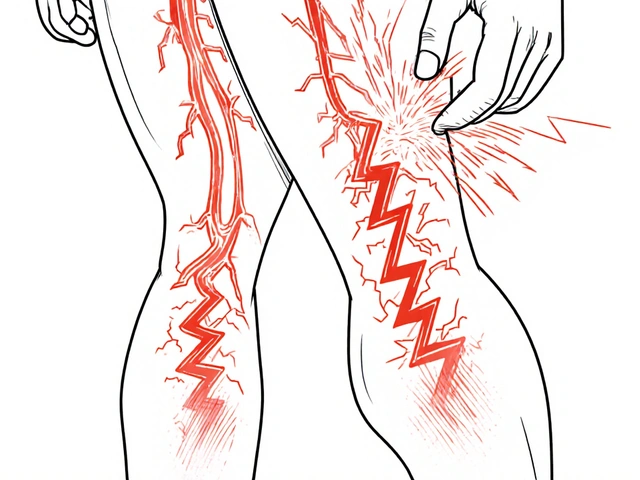If you’re looking up Capoten, you probably want straight answers: what it does, how to take it without problems, and what to watch for. This is the quick, practical guide I’d want if my GP handed me a new script. Expect plain English, UK‑focused tips (BNF/NICE‑aligned), and zero fluff.
- TL;DR: Capoten (captopril) is an ACE inhibitor for high blood pressure, heart failure, post‑heart attack care, and kidney protection in diabetes (type 1). It can cough, drop BP, raise potassium, and nudge up creatinine.
- Take it on an empty stomach (1 hour before meals). Start low, go slow. Get U&E (kidney function and potassium) at baseline and 1-2 weeks after each dose change.
- Stop and seek urgent help for swollen lips/tongue/face (angioedema) or severe dizziness/fainting.
- Avoid potassium supplements, potassium‑sparing diuretics, NSAIDs where possible, and lithium-check with your pharmacist/GP first.
- Not safe in pregnancy (especially after 12 weeks). Use sick‑day rules: pause during vomiting/diarrhoea or dehydration.
What Capoten (captopril) does and who it’s for
Capoten is the brand name for captopril, an ACE inhibitor. It relaxes blood vessels by blocking the enzyme that narrows them. That lowers blood pressure, reduces strain on the heart, and protects the kidneys in certain conditions.
In UK practice (BNF, NICE), doctors use captopril for:
- Hypertension (high blood pressure), often when other first‑line choices aren’t suitable or in specific scenarios.
- Symptomatic heart failure, usually alongside a beta‑blocker and a diuretic; later steps may add MRA (e.g., spironolactone) and SGLT2 inhibitors.
- Post‑myocardial infarction (after a heart attack) to help the heart remodel and reduce future risk.
- Diabetic nephropathy in type 1 diabetes with albumin in the urine-helps reduce protein loss and slow kidney decline.
Why pick captopril specifically? It works fast, which can help during cautious up‑titration in heart failure or when a short‑acting ACE inhibitor is preferred. In the UK, generic captopril tablets commonly come in 12.5 mg, 25 mg, and 50 mg strengths.
One nuance: people of Black African or African‑Caribbean family origin often respond less to ACE inhibitors as single‑agent BP therapy and have a higher risk of angioedema. That’s why NICE leans toward a calcium‑channel blocker first for many patients in that group. Still, captopril remains key in heart failure and post‑MI care across groups when indicated.
Evidence base? ACE inhibitors are standard of care across hypertension (NICE NG136), heart failure with reduced ejection fraction (NICE and ESC), and post‑MI secondary prevention. Captopril was among the first drugs in these classes to show survival benefits in rigorous trials, and its safety profile is well mapped in the BNF and MHRA product information.
How to take Capoten safely: dosing, titration, and monitoring
Food reduces captopril absorption, so take it 1 hour before meals (or 2 hours after). Try to take it the same way each time to keep levels steady.
Typical adult dosing used in UK practice (individualised by your clinician):
| Indication | Starting dose | Titration | Usual target/maximum | Key monitoring |
|---|---|---|---|---|
| Hypertension | 12.5-25 mg 2-3 times daily | Increase every 1-2 weeks as tolerated | Up to 150 mg/day in divided doses | U&E at baseline and 1-2 weeks after changes; BP home logs |
| Heart failure (HFrEF) | 6.25-12.5 mg 2-3 times daily | Double every 1-2 weeks if BP/RFs allow | 50 mg 3 times daily (max 150 mg/day) | U&E 1-2 weeks after each step; watch symptoms and weight |
| After myocardial infarction | 6.25 mg then 12.5 mg TID | Titrate over days to weeks | Up to 150 mg/day in divided doses | Renal function, K+, BP, symptoms |
| Diabetic nephropathy (type 1) | 25 mg 3 times daily | Adjust to proteinuria/BP targets | Often 75 mg/day; up to 150 mg/day | U&E and urine ACR checks |
| Renal impairment | Start lower; extend dosing interval | Titrate slowly with close labs | Reduce max if eGFR low | U&E 1 week after changes; eGFR trend |
Step‑by‑step setup that keeps you safe:
- Baseline checks: U&E (creatinine/eGFR and potassium), BP sitting/standing, weight, and a quick medication review (diuretics, NSAIDs, lithium, ARBs, MRAs, potassium products).
- First dose timing: take it when you can relax for an hour. The first tablet can drop your BP more than later ones, especially if you’re volume‑depleted or on a diuretic.
- Titrate gently: increases every 1-2 weeks if your BP and labs look good. In heart failure, slower is often smarter.
- Recheck U&E 1-2 weeks after starting and after each dose change. Then settle into 3-6‑monthly checks once stable, or more often if eGFR is low.
- Keep a simple BP log: morning and evening readings, seated, after 5 minutes rest. Take the cuff to your next appointment to verify accuracy.
Lab thresholds most clinicians use in practice:
- Creatinine rise up to about 30% from baseline can be acceptable; more than that needs a rethink (dose back, check volume status, review meds, consider renal artery stenosis).
- Potassium 5.0-5.5 mmol/L: tighten diet/meds, consider dose tweak; ≥5.5 mmol/L: usually hold and reassess.
Practical dosing tips:
- Missed dose? If it’s within a few hours, take it. If it’s close to your next one, skip and carry on. Don’t double up.
- Diuretics on board? Your prescriber may reduce or pause them briefly when starting captopril to dodge a big BP drop.
- Food matters with captopril-stick to the “empty stomach” rule to avoid swings in effect.
- Older adults or low BMI: start lower and move slower to avoid dizziness and falls.
- Surgery or a colonoscopy prep coming up? Ask if you should hold the morning dose to avoid low BP under anaesthesia or dehydration.

Side effects, red flags, and interactions to watch
Most people feel fine on captopril, but a few well‑known issues deserve attention.
Common and usually manageable:
- Dry cough (persistent, tickly). Can start weeks in. If it’s miserable, your GP may switch you to an ARB.
- Low blood pressure symptoms: light‑headed, tired, sometimes headaches-especially after the first dose or a dose increase.
- Changes in taste, dry mouth, or mild rash-often settle or ease with dose adjustments.
Less common but important:
- High potassium (hyperkalaemia): muscle weakness, palpitations, or no symptoms at all-this is why the blood tests matter.
- Kidney function changes: most rises in creatinine are small and expected; large jumps need action.
- Angioedema (rare but urgent): swelling of lips, tongue, face, or throat; hoarse voice or trouble breathing. Call 999-do not wait.
- Neutropenia (very rare): watch for fever, sore throat, mouth ulcers-report if persistent, especially if you have kidney disease or autoimmune disease.
Drug and lifestyle interactions worth knowing:
- NSAIDs (ibuprofen, naproxen, diclofenac): regular use can blunt BP control and raise AKI risk-paracetamol is safer for most pain. If you need NSAIDs, use the lowest dose for the shortest time and stay hydrated.
- Potassium‑raising meds: potassium supplements, salt substitutes with potassium, spironolactone/eplerenone, trimethoprim, ciclosporin/tacrolimus-ask for a review before mixing.
- Lithium: levels can rise to toxic; usually avoid combining or monitor very closely.
- Aliskiren: avoid with ACE inhibitors in diabetes or renal impairment.
- ARNI (sacubitril/valsartan): do not overlap-leave a 36‑hour washout between stopping one and starting the other to reduce angioedema risk.
- Alcohol: can accentuate dizziness from BP lowering.
Food and hydration:
- Stay well hydrated, especially in summer or if you exercise a lot.
- Keep high‑potassium foods reasonable if your levels tend to run high (e.g., large amounts of bananas, dried fruit, some salt substitutes). No need for a strict list unless your clinician advises one.
Special cases:
- Pregnancy: do not use-ACE inhibitors can harm the baby, especially after 12 weeks. If you’re planning pregnancy, talk to your GP about switching ahead of time.
- Breastfeeding: small amounts pass into milk. Often considered compatible with caution in older infants, but avoid in preterm or neonatal babies; discuss with your prescriber.
- Diabetes: captopril can modestly improve proteinuria; watch potassium, especially if you take an MRA or have CKD.
- Black patients: higher angioedema risk-seek urgent help at the first sign of facial or tongue swelling.
Source backbone used by UK clinicians: BNF (2025), NICE guidance for hypertension and heart failure, MHRA patient information, and major cardiology society guidance (e.g., ESC/ESH). Your prescriber tailors all of this to you.
Practical checklists, scenarios, and quick answers
Fast, real‑life help you can act on today.
Before you start-5‑point checklist:
- Do you have baseline U&E (creatinine/eGFR and potassium)?
- Are you taking any regular NSAIDs, potassium supplements, lithium, or a potassium‑sparing diuretic? If yes, flag it.
- Have you got a BP monitor at home that fits your arm? Bring it to your next appointment to validate.
- Do you know when your next blood test is due (1-2 weeks after starting)? Put it in your calendar.
- Any chance of pregnancy? If yes, discuss alternatives now.
How to titrate without drama-simple rules of thumb:
- Increase no more often than every 1-2 weeks.
- If you feel woozy or your systolic BP dips under about 95 mmHg repeatedly, hold the dose where it is and call your clinic.
- If creatinine rises ≤30% and potassium stays <5.5 mmol/L, you can usually continue with careful review.
Sick‑day rules (to prevent kidney hits):
- Pause captopril if you have vomiting, diarrhoea, fevers with dehydration, or if you’re barely drinking.
- Restart 24-48 hours after eating and drinking normally again.
- If symptoms last beyond 48 hours, call your GP or NHS 111.
Storage and handling:
- Store tablets in a dry place at room temperature.
- Keep out of reach of children and pets.
- Check the pack strength before each dose-12.5 mg tablets look like 25 mg in some brands.
Two quick scenarios:
- New cough after 3 weeks: it’s dry, persistent, worse at night. Bloods are fine. This is classic ACE inhibitor cough. If it’s annoying, speak to your GP about switching to an ARB.
- Potassium at 5.6 mmol/L on your first recheck: your GP holds captopril, repeats labs, reviews meds for hidden potassium (including salt substitutes), and considers a lower dose or an alternative.
Mini‑FAQ
- How fast does it work? The first dose can start lowering BP within 30-60 minutes; full effect builds over days to weeks with titration.
- Can I take it with food? You can, but absorption drops. Best 1 hour before meals for consistent effect.
- Is once‑daily dosing OK? Captopril is short‑acting, so most people need 2-3 doses daily. If you want once daily, ask about a longer‑acting ACE inhibitor.
- What if my creatinine bumps? Small rises are expected. Big jumps or a rapid fall in urine output needs quick review.
- Can I stop it abruptly? Yes, but don’t without a plan-you may rebound on BP or heart failure symptoms.
- Do I need to avoid exercise? No. Just stand up slowly when you’re new to it to avoid dizziness.
When to seek help right now:
- Swelling of lips, tongue, face, or throat; trouble breathing-call 999.
- Fainting, chest pain, or black, tarry stools-urgent assessment.
- No urine for 12+ hours or severe dehydration-same‑day care.
Credibility notes for the cautious reader: dosing ranges, test timing, and safety signals here match British National Formulary practices (2025), with indications and targets guided by NICE for hypertension and heart failure, and MHRA product characteristics. Evidence on pregnancy risk comes from decades of pharmacovigilance and regulatory labelling. If your clinic uses slightly different lab cut‑offs, trust their protocol-it’s based on your risk profile.
Next steps
- If you’re starting today: set a reminder for your first U&E in 7-14 days and keep a BP log.
- If you’re troubleshooting side effects: note the timing, dose, and any new meds-then call your GP or pharmacist with that info.
- If the dosing schedule is hard: ask about longer‑acting ACE inhibitors or ARBs that fit your routine.
Final thought: the drug is proven. The art is in the setup-right dose, right checks, and a plan for blips. Get those right, and Capoten tends to behave.






Comments
9 Comments
Sandridge Nelia
Thanks for this! I’ve been on captopril for 6 months for diabetic nephropathy and honestly, the dry cough was driving me nuts-switched to losartan and it vanished overnight. Also, the empty stomach tip? LIFE CHANGER. I used to take it with breakfast and wondered why my BP was all over the place 😅
Mark Gallagher
Why are you people still using captopril? In the U.S., we’ve had longer-acting ACE inhibitors for decades. This is like recommending a flip phone because it has a dial tone. Also, you mention UK guidelines like they’re gospel-this isn’t the NHS, folks. Get with the program.
Wendy Chiridza
Big fan of the sick-day rules section. I had a bad stomach bug last winter and kept taking my captopril because I didn’t know better. Ended up in the ER with a creatinine spike. Never again. This guide saved my kidneys
Pamela Mae Ibabao
Okay but can we talk about how the potassium warning is basically a quiet scream? I had a patient who was eating 3 bananas a day, taking spironolactone, AND using salt substitute. Then she got a potassium of 6.1. She was fine. No symptoms. Just… dead. Like, literally. I mean, it’s not even dramatic. It’s just math. And math doesn’t care how nice you are.
Gerald Nauschnegg
OMG I JUST STARTED CAPTOPRIL LAST WEEK AND MY TASTE IS OFF!! I CAN’T TASTE ANYTHING!! Is this normal?? I thought I had COVID again 😭 I’m gonna stop it tomorrow unless someone says it’s okay!!
Palanivelu Sivanathan
...and so the ACE inhibitors whisper through the veins like ancient rivers... they carry not just blood pressure... but the weight of human frailty... captopril... a child of science... born in the labs of the 70s... yet here we are... in the age of TikTok... still struggling to swallow a pill... with empty stomach... as if fasting were a sacrament... oh humanity... why do we fear the body’s wisdom...?
Joanne Rencher
Ugh, another one of these ‘guide’ posts. Like anyone actually reads this. I just take my pill and hope for the best. Also, why is everyone so obsessed with potassium? Just eat a banana and chill.
Erik van Hees
Actually, the 30% creatinine rise threshold is outdated. The 2023 KDIGO guidelines say up to 45% is acceptable in stable CKD patients on ACEi, as long as it plateaus. Also, NICE is too conservative-US guidelines allow higher doses in heart failure. You’re giving people outdated info. This is why patients get confused.
Cristy Magdalena
When I first started captopril, I cried for three days because I thought I was dying. The dizziness, the taste loss, the fear that my kidneys were failing… I felt so alone. Then I found this post. It didn’t fix my body, but it fixed my mind. Thank you. I’m not broken. I’m just being carefully guided.
Write a comment